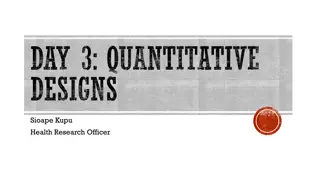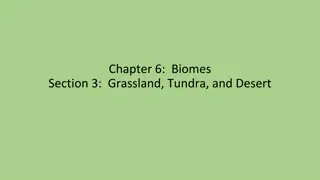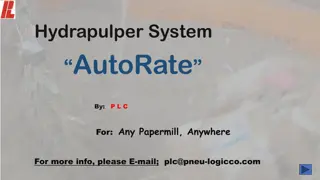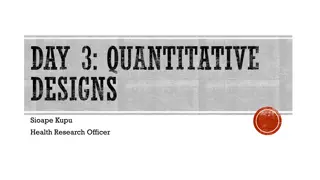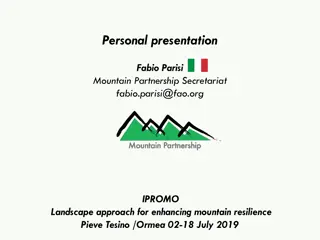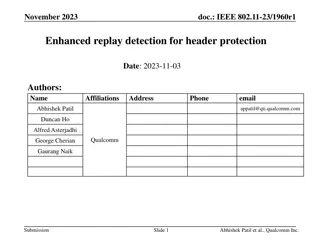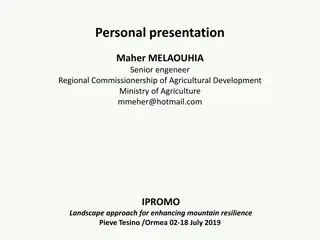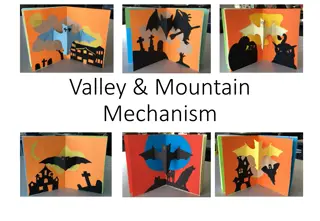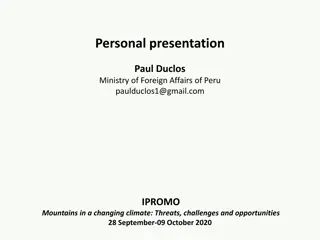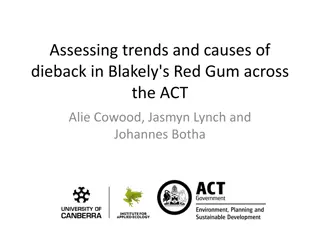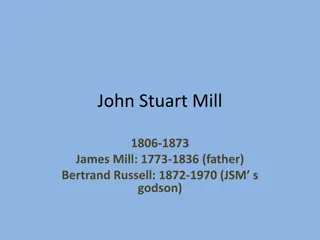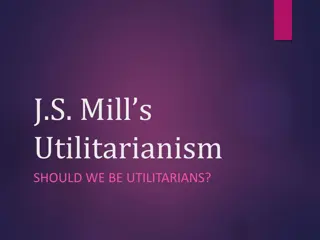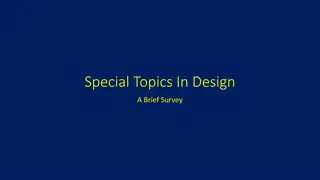Grassy Mountain TSF and Mill Designs Technical Questions
Exploring the current Tailing Storage Facility (TSF) design's efficacy and compliance with industry standards and regulatory requirements. Discusses factors like risk reduction, liner integrity, leak detection, water balance, and environmental protection measures. Evaluates if the existing design meets DEQ requirements and considers feasibility of alternative TSF designs. Addresses subgrade preparation, liner repair, leachate detection, and monitoring systems effectiveness.
Download Presentation

Please find below an Image/Link to download the presentation.
The content on the website is provided AS IS for your information and personal use only. It may not be sold, licensed, or shared on other websites without obtaining consent from the author.If you encounter any issues during the download, it is possible that the publisher has removed the file from their server.
You are allowed to download the files provided on this website for personal or commercial use, subject to the condition that they are used lawfully. All files are the property of their respective owners.
The content on the website is provided AS IS for your information and personal use only. It may not be sold, licensed, or shared on other websites without obtaining consent from the author.
E N D
Presentation Transcript
DOGAMI Technical Questions on the Grassy Mountain TSF and Mill Designs Thursday, February 2, 2023
Is the current Tailing Storage Facility (TSF) design the best available, practicable and necessary technology in the industry (globally)? Why and how? TSF design by Golder Associates with Oregon Professional Engineer licensing. TSF design incorporated OAR 340, 632, 635, 690. Factor of Safety developed in consultation with OWRD. Zero-discharge facility. Containments with leak detection for process solution in impoundments, channels, piping, and other systems. Depth to groundwater is more than 120 feet (no upward pressure on liner). TSF water balance accounts for 500-year, 24-hour storm event (deterministic water balance). Tailings supernatant pond appears to be in direct contact with primary liner on the eastern side of the tailings impoundment. Operating Maintenance and Surveillance (OMS) Manual and Emergency Action Plan would be prepared prior to operation; OMS Manual should include observations of the avian and wildlife protection measures plus groundwater levels and water chemistry downgradient of the TSF.
Six to twelve inches of native prepared subgrade is proposed to be placed immediately below the TSF liners. Leachate detection and leachate collection are required because industry knows liners leak. Q. Will increasing the subgrade depth to 18 inches using select-grade aggregate reduce risks of liner failure? Q. During operations, and prior to reclamation and closure, is liner repair feasible? Q. Is the leachate detection and monitoring system adequate to prevent a release to the environment (i.e., zero (0) discharge)? Field and laboratory testing was conducted to characterize the subgrade materials and select their depth. Liner repair is generally not feasible during operations for all instances; leakage minimized operationally. The types of leak detection systems have been effective in identifying seepage through TSF liners so that tailings management can be implemented to address the seepage and limit potential effects to receiving water quality.
Does the current TSF design meet all DEQ requirements under OAR 340-043? While the facility is designed with fencing, the tailings design document does not describe the fencing or how it would be protective of wildlife. The preliminary closure plan calls for the placement of an evapotranspiration soil cover while OAR 340- 043-0150 calls for use of a composite cover designed to prevent water and air infiltration . The tailings design references groundwater monitoring using the site groundwater production wells but does not describe how these wells would be located and utilized to monitor potential tailings impoundment effects on groundwater.
Are practicable alternative TSF designs available? As defined in OAR 632-037-0010(2, 19, & 24) and OAR 632-037-0118. Other than alternative locations, the requirements around TSF designs for conventional tailings disposal are fairly prescriptive. Different thicknesses of subgrade, pipe sizes, etc. could be used, but these are generally not material to the environmental protectiveness of the TSF design once these components have been initially designed to meet protective criteria. Alternative Tailings Management: Filtered and Stacked Tailings Creates filtrate water and tailings cake in place of tailings slurry May affect zero-discharge design Alternative Tailings Management: Paste Tailings Used underground as backfill Reduced surface management Increased cement delivery and usage
The applicants air quality consultants have recently proposed to DEQ a tailings aqueous surface (supernatant pool?) free cyanide (CN) concentration of 1.0 mg/l. DEQ air quality staff have accepted that proposed value. How does a value of 1.0 mg/l free CN equate to WADCN? Free cyanide is a component of WAD cyanide. The ratio of free cyanide to WAD cyanide depends on the availability of metals that to complex with the free cyanide. The free cyanide concentration is always less than the WAD cyanide concentration. A quantitative relationship between free cyanide and WAD cyanide would only be determinable from metallurgical testing and/or monitoring of the facility.
Does the current mill design meet accepted industry standards, and is it the best available, practicable and necessary technology? Why and how? Mill design by Ausenco with Oregon Professional Engineer Licensing Secondary containment for processing materials and solutions at least 110% of the largest container volume plus allowances for a 2.28 inch, 24-hour storm event. Water stops are conventionally included in concrete containment designs to protect against process solutions existing containment through joints and seems in the concrete. Concrete coatings are only described for hydrochloric acid areas. Designs typically describe how spills would be evacuated from containments.
Does the current mill design meet accepted industry standards, and is it the best available, practicable and necessary technology? Why and how? The design includes equipment and infrastructure for the detoxification and neutralization of cyanide in the mill tailings. When combined with personal protective equipment and industrial hygiene controls during operations, these control measures are typical for mill facilities. Mercury controls include a retort to collect elemental mercury from the refining processes. Gas scrubbers are equipped with mercury control carbon beds for absorption of mercury from the gas streams. Prior to construction, air quality permits typically require a Maximum Available Control Technology (MACT) analysis of the mercury control devices to confirm that they are up to date per industry and regulatory standards. The design report references the site reclamation plan regarding decommissioning and closure. That reclamation plan calls for the dismantling, salvage, sale, or authorized off-site disposal of mill infrastructure. Non-movable mill components such as slabs and foundations would be recontoured in place. In addition to these proposed measures, a closure-period inspection of process facility components for contamination is common practice prior to closing those components in place. If contamination is identified, appropriate remediation is undertaken prior to recontouring the components in place.
Do the technologies, methods and designs proposed in the CPA and its appendices ensure complete mitigation of acid rock drainage in the underground workings, i.e., do they ensure complete protection against groundwater contamination? The site has a negative water balance. While a negative water balance does not preclude acid- generation, it does limit the acid-generation rate. The use of inert rockfill and 7% cemented rockfill add neutralization potential that precludes acidic drainage in the backfilled portions of the underground. In unbackfilled areas, exposure rock is covered with cement ground support which limits the exposure of sulfides to air and water. Acidic drainage could occur where sulfide concentrations are very high. These instances are rare and location-specific, and can be addressed via additional cement at the specific locations.
The 2021 CPA section on Cement Rock Fill states that the addition of 5-7% Portland cement will be added to basalt and waste rock so to provide acid neutralizing capacity and to create workable surfaces upon which further mining activities will occur in the underground workings. Is practicable technology available that can monitor acid formation in real time in the underground workings data that would more precisely guide the Cement Rock Fill mixture assembled at the surface? If so, is the Cement Rock Fill sufficient and durable over time to prevent ARD? If so, how is acid formation best monitored after the CRF has been placed? The best monitoring technology would involve collecting a quarterly sample of the RF and CRF and submitting them for acid- base accounting analysis and a Meteoric Water Mobility Procedure laboratory test. This would confirm the pH and leachability of these backfill materials. Once placed in the underground workings, the backfilled materials are physically and geochemically stable. During operations, inspections of the backfill could be used to note any seepage and its seepage chemistry. Following operations and the closure period, direct observation of the backfill performance is difficult as the groundwater recovers into the mine workings when dewatering ceases. At this point, any further oxidation of sulfide minerals becomes inhibited by the groundwater s displacement of atmospheric oxygen which is a necessary component of the oxidation reaction. In the closure and post-closure periods, affects of RF and CRF on groundwater chemistry can be monitored via groundwater monitoring wells downgradient of the underground workings.
Approved Mine Plan Approved Reclamation Plan Required Mitigation Measures Contingency Cost Estimate Reclamation Cost Estimate Selection of Surety Instruments
Surety Bonds Cover Buildings and foundations (including equipment removal and demolition), Electrical power lines, Electrical substations and transformers, Exploration drillholes and trenches, Exploration roads and pads, Fences, Heap leach ore processing facilities, Laydown yards, Landfills, Material borrow areas and quarries, On-site worker housing, Open pits, Operational ponds (e.g., process ponds), Operational stormwater controls (including rock-lining, gabions, etc.), Pipelines (e.g., culverts plus surface and buried pipelines), Power generation equipment, Railroad spurs, Roads (access and mine haulage), Process water inventory management, Septic systems, Site mechanical infrastructure (e.g., conveyors, crushers, stackers), Tailings storage facilities, Tanks, Underground mining openings, Waste rock disposal facilities, Water treatment, and Well abandonment. Construction management, Contractor mobilization and demobilization, Haulage of materials (e.g., facility cover materials), Site security, Stormwater and sediment control during closure implementation, Waste disposal, and Post-closure performance monitoring.
Unforeseen Events Unplanned circumstances involve an event not authorized within the approved mine plan and events that occur when the mine operator is no longer viable to address an event. Examples Unpredicted effect on a water right that did not manifest until post-closure, Unpredicted water quality effects that did not manifest until post-closure, Failure of a long-term passive water treatment system during the post-closure period that had been previously effective, and Failure of long-term habitat improvement measures during the post-closure period that had been previously effective. Managing Unforeseen Events Keeping bonds updated, Maintaining an updated process solution management plan for temporary closure along with allowances for the facilities and equipment needed to implement that plan, Requiring a notification period ahead of any temporary or permanent cessation of permitted mine activities, and Identifying and training regulatory agency staff for assumption of mine reclamation management duties. Risk Analysis for Approved Project Types of unforeseen events to incorporate Cost estimation to address Surety instrument or Long-Term Contingency Fund
Water Treatment Costs Interim water management (e.g., continued circulation of process waters while preparing for water treatment and/or disposal), Impacted groundwater and/or surface water capture and active water treatment, Closure period water management (e.g., evaporation, active water treatment plant discharge), Post-closure water (e.g., conversion to long-term monitored passive water treatment upon success of closure period water management), and Water quality performance monitoring.
Surety Updating and Auditing Update Audit 1. When there is a change to the mine plan, 2. When there is a change to the reclamation plan, and 3. Per a set schedule to account for changes in unit rates. Financial Assurance, Terms of Reclamation Plan Approval, Authorized Officers for regulatory agencies, the required Monitoring Plan, As-Built Maps for the facilities, Inspections, and Plan Modifications approved during the five-year period.
Surety Contingencies Contingency rates between 2% and 50% depending on jurisdiction and total direct costs Other factors applied: Engineering, Design, and Construction Planning (4% to 8%), Insurance (approximately 15%), Performance Bonding (approximately 3%), Contract Administration (6% to 10%), and Government Indirection Costs (approximately 21%).
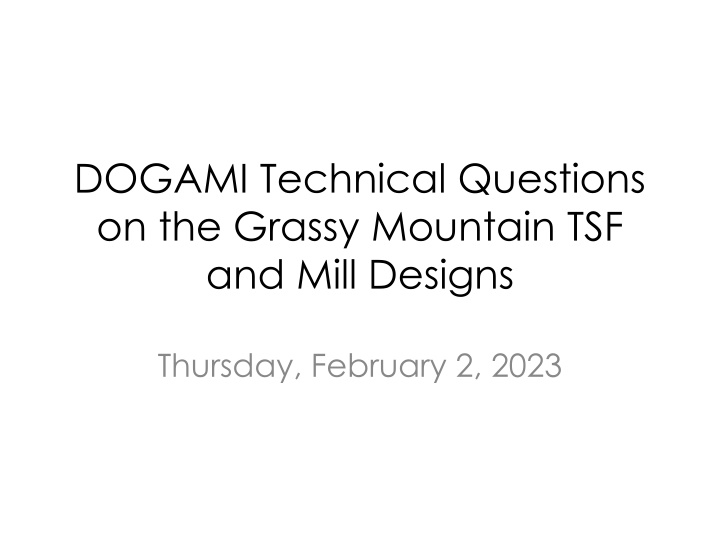


![[PDF READ ONLINE] Mountain Claiming (BIG-Secrets of Mountain Men Book 3)](/thumb/42287/pdf-read-online-mountain-claiming-big-secrets-of-mountain-men-book-3.jpg)
